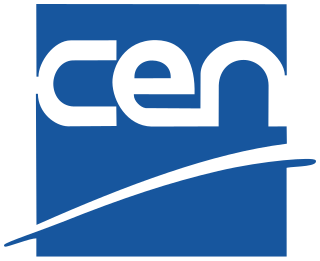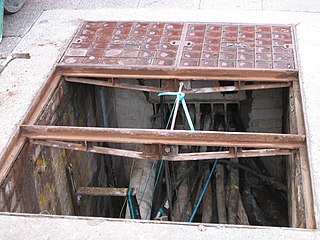
A septic tank is an underground chamber made of concrete, fiberglass or plastic through which domestic wastewater (sewage) flows for basic treatment. Settling and anaerobic processes reduce solids and organics, but the treatment efficiency is only moderate. Septic tank systems are a type of simple onsite sewage facility (OSSF). They can be used in areas that are not connected to a sewerage system, such as rural areas. The treated liquid effluent is commonly disposed in a septic drain field which provides further treatment. However, groundwater pollution may occur and can be a problem.
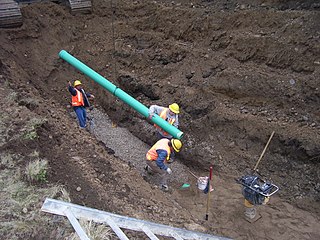
A sanitary sewer or foul sewer is an underground pipe or tunnel system for transporting sewage from houses and commercial buildings to treatment facilities or disposal. Sanitary sewers are part of an overall system called a sewage system or sewerage.

A storm drain, storm sewer, surface water drain/sewer, or stormwater drain is infrastructure designed to drain excess rain and ground water from impervious surfaces such as paved streets, car parks, parking lots, footpaths, sidewalks, and roofs. Storm drains vary in design from small residential dry wells to large municipal systems.
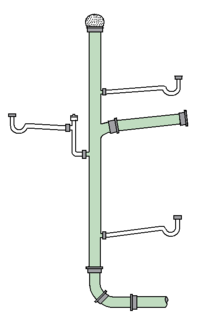
In modern plumbing, a drain-waste-vent is part of a system that removes sewage and greywater from a building, and regulates air pressure in the waste-system pipes to aid free flow. Waste is produced at fixtures such as toilets, sinks, and showers, and exits the fixtures through a trap, a dipped section of pipe that always contains water.

A leachate is any liquid that, in the course of passing through matter, extracts soluble or suspended solids, or any other component of the material through which it has passed.

Sewage farms use sewage for irrigation and fertilizing agricultural land. The practice is common in warm, arid climates where irrigation is valuable while sources of fresh water are scarce. Suspended solids may be converted to humus by microbes and bacteria in order to supply nitrogen, phosphorus and other plant nutrients for crop growth.
Sanitary engineering, also known as public health engineering, is the application of engineering methods to improve sanitation of human communities, primarily by providing the removal and disposal of human waste, and in addition to the supply of safe potable water. Traditionally a branch of civil engineering, in the mid-19th century, the discipline concentrated on the reduction of disease, then thought to be caused by miasma. This was accomplished mainly by the collection and segregation of sewerage flow in London specifically, and Great Britain generally. These and later regulatory improvements were reported in the United States as early as 1865.
CEN/TC 251 is a technical decision making body within the European Committee for Standardization (CEN) working on standardization in the field of Health Information and Communications Technology (ICT) in the European Union. The goal is to achieve compatibility and interoperability between independent systems and to enable modularity in Electronic Health Record systems.

A vacuum sewer or pneumatic sewer system is a method of transporting sewage from its source to a sewage treatment plant. It maintains a partial vacuum, with an air pressure below atmospheric pressure inside the pipe network and vacuum station collection vessel. Valves open and reseal automatically when the system is used, so differential pressure can be maintained without expending much energy pumping. A single central vacuum station can collect the wastewater of several thousand individual homes, depending on terrain and the local situation.
Transport standards organisations is an article transport Standards organisations, consortia and groups that are involved in producing and maintaining standards that are relevant to the global transport technology, transport journey planning and transport ticket/retailing industry. Transport systems are inherently distributed systems with complex information requirements. Robust modern standards for transport data are important for the safe and efficient operation of transport systems. These include:
The EN 54 Fire detection and fire alarm systems is a mandatory standard that specifies requirements and laboratory test for every component of fire detection and fire alarm system and it allows the free movement of construction products between countries of the European Union market.

Effluent sewer systems, also called septic tank effluent drainage (STED) or solids-free sewer (SFS) systems, have septic tanks that collect sewage from residences and businesses, and the effluent that comes out of the tank is sent to either a centralized sewage treatment plant or a distributed treatment system for further treatment. Most of the solids are removed by the septic tanks, so the treatment plant can be much smaller than a typical plant. In addition, because of the vast reduction in solid waste, a pumping system can be used to move the wastewater rather than a gravity system.
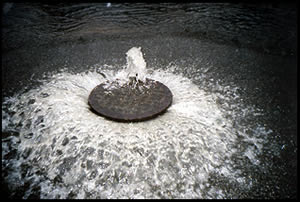
Infiltration/Inflow (I/I) causes dilution in sanitary sewers. Dilution of sewage decreases the efficiency of treatment, and may cause sewage volumes to exceed design capacity. Although inflow is technically different from infiltration, it may be difficult to determine which is causing dilution problems in inaccessible sewers. The United States Environmental Protection Agency defines the term infiltration/inflow as combined contributions from both.

The history of water supply and sanitation is one of a logistical challenge to provide clean water and sanitation systems since the dawn of civilization. Where water resources, infrastructure or sanitation systems were insufficient, diseases spread and people fell sick or died prematurely.
EN 12566 - Small wastewater treatment systems for up to 50 PT refers to a set of European standards which specify the general requirements for packaged and/or site assembled wastewater treatment plants used for domestic wastewater treatment for up to 50 PT. The standards consist of the following parts:
EN 12255 - Wastewater treatment plants refers to a set of European standards which specify the general requirements for structures and equipment that relate to wastewater treatment plants for a total population of more than 50 PT. This standard, however, does not include the design of a treatment processes itself. The standards consist of the following parts:
CEN/TC 10 is a technical decision making body within the CEN system working on the establishment of safety rules for the construction and installation of lifts, escalators, and passenger conveyors in the European Union.
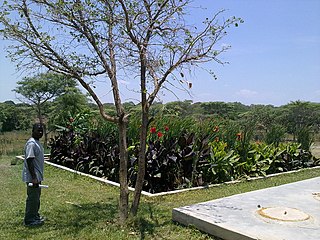
Decentralized wastewater systems convey, treat and dispose or reuse wastewater from small communities, buildings and dwellings in remote areas, individual public or private properties. Wastewater flow is generated when appropriate water supply is available within the buildings or close to them.

A gravity sewer is a conduit utilizing the energy resulting from a difference in elevation to remove unwanted water. The term sewer implies removal of sewage or surface runoff rather than water intended for use; and the term gravity excludes water movement induced through force mains or vacuum sewers. Most sewers are gravity sewers; because gravity offers reliable water movement with no energy costs wherever grades are favorable. Gravity sewers may drain to sumps where pumping is required to either force sewage to a distant location or lift sewage to a higher elevation for entry into another gravity sewer, and lift stations are often required to lift sewage into sewage treatment plants.
CEN/TC 434 is a technical body within the European Committee for Standardization (CEN) developing standards in the field of Electronic Invoicing. CEN/TC 434 has developed the European Standard on Electronic Invicing and other ancillary standardization deliverables required by the European Directive 2014/55/EU.
